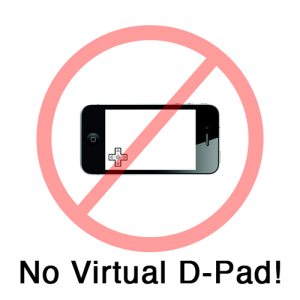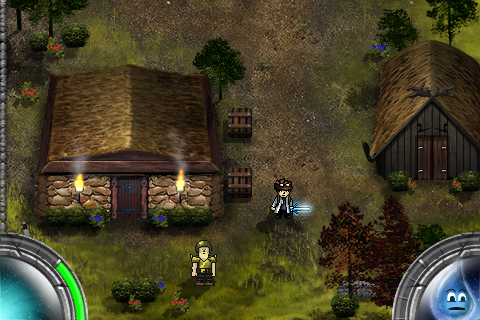Hi everyone! We just wanted to share a quick update on Fara's development progress. Things have been going great and we currently have a build of the game that we consider Beta. We are really excited that things are moving along so quickly and we'll be announcing the official launch date of the game, as well as our trailer (made by the awesome Graham Dunn) very soon!
Also, the Fara media gallery has been updated with current images from the game. We've also added some previously unreleased areas/gameplay to the screenshots, so be sure to check it out!
-Blog-
Virtual D-Bad (Pun!) - How Virtual D-Pads Ruin iPhone Games
NO VIRTUAL D-PAD. This was the phrase that rattled around in my brain as we began designing our new game. Lots of iPhone games make use of this dreaded control scheme and I've yet to see it work well in any game. From Street Fighter IV to FIFA, developers freaking LOVE the virtual d-pad. Even more frustrating is the fact that many games, such as the two series I mentioned before, have solid core gameplay systems but are ruined by this strange design decision.
Some game designs simply aren't meant for the iPhone. The iPhone has a touch screen, not a gamepad (surprise!), so games requiring lots of tactile feedback just don't work on the device. 97 hit combos, strafing head shots, and precise platforming are several gameplay mechanics that, when paired with a virtual d-pad, can become an iPhone chucking frustration.
Other games, such as Mirror's Edge on the iPhone, treat the device as a new, exciting way to create a similar gameplay experience to their console brethren, without the need to emulate it 100 percent. EA's game uses a clever swiping control screen that proves a really satisfying way to move the character around. By making use of an input method that iPhone users already understand, the game's control scheme feels totally natural. Winning!
As we began assembling our iPhone game, Texel and I were determined to avoid the virtual d-pad. So far our "no d-pad" mentality has worked out very well. The user simply taps where the character should move, double taps for attacks/interactions, and has use of two HUD buttons for inventory/saving/options. Simplicity. It's why we all bought an iPhone in the first place.

First screenshots and some thoughts from Pixel....
First, I think an introduction is in order. I am half of the game studio Pixel and Texel, more specifically the Pixel half, and I'll be sharing my thoughts, screenshots, and progress as we develop our new action RPG for the iPhone! My real name is obviously not Pixel (it's Andrew), but I think the name is indicative of what I've had on the brain lately. As we work on our new game, I've had to come to grips with creating a visual style that balances nostalgia with our modern game engine. Here's a first peek at some screenshots taken from our current build:



I'm so excited to share these first images! It's been an interesting process figuring out the style for our game. As our studio began thinking about the kind of title we'd like to develop, we realized we had a deep love for classic action/adventure/RPG games. Titles like The Legend of Zelda: A Link to the Past and The Secret of Mana live on in many gamer's minds as fantastic games. We decided to take our love of this genre and create something new for the iPhone.
One aspect of these classic games that always bothered me was repetition. Before I understood sprite, tiles, and the technical limitations of older game consoles, I constantly pondered the "sameness" of game worlds. I hated how every tree in the forest looked the same and how this rock looked just like the last fifty rocks I saw. Some action RPGs on the iPhone still use the tile convention for game creation, and, frankly, I think the look is too stale for the modern era.
Avoiding this stagnation became one of the most important parts of our design as Texel began creating his engine. In the end, we were able to treat the entire game world almost as a living painting, where I'm given a giant canvas and an almost infinite number of object types I can place. This sort of freedom has been immensely satisfying, because I can avoid the dreaded "tile" look and have the sort of variety in the world that makes it feel like a living and breathing place.
I love 2D pixel art. From Metal Slug to Street Fighter II, some of the most beautiful things I've ever witnessed on a game screen are loving animated sprites. As development on our game continued, I felt like I wanted to convey this nostalgia in our game world. My solution was that all characters should be rendered in a classic pixel style. I first worried that sprites with a hard black outline would seem out of place in a carefully painted world, but was pleasantly surprised when I finished the first character. The difference in style really helps the characters stand out against the background! As development goes on, I'll share some tricks/thoughts I've had as I create these little guys. Pixel art is really difficult but very satisfying!
